You are here
Guidance on Personal Protective Equipment: health professionals
Information to help healthcare organisations update their operating procedures.
The demand for face masks (including surgical masks and respirators), surgical and isolation gowns, and surgical suits may overtake the supply available to healthcare organisations during the COVID-19 pandemic. The Department of Health and Aged Care including the Therapeutic Goods Administration (TGA) and the Office of Health Protection (OHP) has prepared the following information to assist healthcare organisations in awareness, selection, and supply of PPE.
For COVID-19 related information go to COVID-19 personal protection equipment (PPE)
Summary
For face masks, gloves and gowns, the OHP and TGA suggest that health professionals follow the recommendations below, based on the supply needs of their healthcare organisations.
- Be aware that shortages may occur and plan accordingly in a composed manner.
- Face masks, gloves and gowns intended by the manufacturer for use in an Australian hospital setting should be included on the Australian Register of Therapeutic Goods (ARTG). It is advised that you source your supplies bearing this in mind.
- Face masks, gloves and gowns not intended by the manufacturer for use in a hospital or clinical setting are not required to be included in the ARTG, even if they are used in a hospital or clinical setting.
- Use face masks, gloves and gowns according to labelling/Instructions for Use (IFU).
- Follow your healthcare facilities' infection control policies around the use of face masks, gloves and gowns.
Supply needs in health care organisations
Supply levels are categorised at three levels:
- Standard conventional supply levels: supply levels are adequate to provide patient care without any change in routine practice.
- Contingency supply levels: limited supply levels may change patient care, but may not have a significant impact on patient care and healthcare provider safety.
- Crisis supply levels: may need to be considered if face mask or gown demand exceeds the supply.
While standard conventional supply levels or contingency supply levels are available, all IFU instructions should be adhered to, such as single use and clinical guidelines and protocols.
Recommendations for crisis supply levels
Although the following recommendations for gowns, gloves and face masks do not comply with the IFU for these items, they can be considered where there is no other alternative.
It should be noted that the efficacy of gowns, gloves and masks cannot be assured when used after their expiry date, but should be used where there is no alternative.
Non-sterile PPE including masks, gowns and gloves that do not make any therapeutic claims are regulated as general consumer items and do not need to be included in the ARTG before they can be supplied.
PPE including face masks, gowns and gloves that are presented or claim to be for therapeutic use, such as surgical or examination masks, or respirators intended to reduce or prevent the transmission of disease or micro-organisms (such as bacteria or viruses) between people, meet the definition of a medical device. These products are regulated by the TGA under the Therapeutic Goods Act 1989 and will need to be included in the ARTG before they can be supplied.
Facemasks
Utility mask
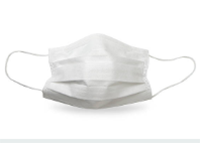
A simple, flexible barrier that is placed over the nose and mouth during short exams and visitations, or during short procedures that do not produce fluid, spray or aerosols. Utility masks are not regulated as medical devices and are not recommended to provide protection from COVID-19.
Surgical mask
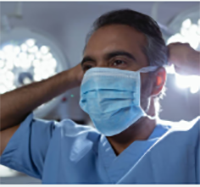
A fluid-resistant, disposable device intended to be placed over the nose and mouth of medical personnel or patients who are infected or displaying symptoms, to create a physical barrier between the mouth and nose of the wearer and prevent the transmission of fluid, spray and/or droplets during surgery or patient examination. Surgical masks are graded as level 1, 2 or 3 based on the level of protection provided, or fluid resistance.
Respirators
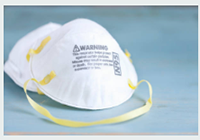
A filtering face piece respirator (FFR) that is designed to form a very close seal around the nose and mouth, protecting the wearer from exposure to airborne particles including pathogenic biological airborne particulates such as viruses and bacteria. Respirators are often labelled with the effective particulate filtration they have been tested for to ensure they remove the minimum specified percentage of solid and liquid aerosols. For example, N95 respirators are effective in removing a minimum of 95% of solid and liquid aerosols that do not contain oil. Respirators are a single use item. These respirators are not fluid resistant.
The consumer or user of respirators should review the similarities and differences between respirators in terms of their specifications and consider their suitability for the settings in which they will be used.
Surgical respirator
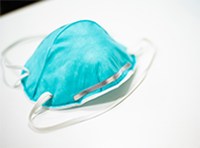
A filtering face piece respirator (FFR) that is designed to form a very close seal around the nose and mouth, protecting the wearer from exposure to airborne particles including pathogenic biological airborne particulates such as viruses and bacteria. Respirators are often labelled with the effective particulate filtration they have been tested for to ensure they remove the minimum specified percentage of solid and liquid aerosols. Surgical respirators are differentiated from standard respirators as they have also been tested for fluid resistance against penetration by synthetic blood under different pressures, such as may occur during certain high risk medical procedures.
In addition to the N95 designation (with reference to the United States NIOSH 42 CFR Part 84), there are other FFR classes including FFP2 (Europe EN 149-2001), KN95 (China, GB2626-2019), P2 (Australia/ New Zealand AS/NZS 1716:2012). A comparison of these standards are provided at: Comparison of P2, FFP2, KN95, and N95 and Other Filtering Facepiece Respirator Classes (pdf,191kb)
Clear face masks
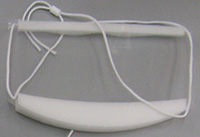
Clear/transparent face masks are advantageous for some settings, including for speech pathologists or when communicating with the deaf and hard-of-hearing community. These products may offer the same level of protection from fluid splashes as visors, due to the materials that they are constructed from. However, these face masks may not adequately prevent the transmission of droplet organisms and caution should be taken in the use of these products in high risk settings.
Transparent masks in general may only claim conformity to a standard such as EN14683, if they have met all of the requirements of the standard. If only partial compliance is achieved then they must not be labelled or advertised as being compliant with the full standard.
The consumer or user of the product should review the manufacturer's product specifications and intended purpose to ensure suitability for the setting in which they will be used.
Guidance on crisis supply levels
While not recommended, where there is low supply and/or high demand, surgical masks and respirators can be used past their shelf life if:
- the straps are intact;
- there are no signs of visible damage; and
- proper fit can be achieved for respirators.
Where there is high demand and/or limited access to surgical masks, healthcare facilities could consider allowing healthcare professionals to continue wearing the same mask between treating patients with the same diagnosis or infectious disease.
The use of masks should be prioritised for aerosol-generating procedures. These include but are not limited to suctioning and nebuliser treatments (currently nebulising medication is not recommended due to aerosolisation risk).
Note
The TGA is aware of identified issues with some filtering face piece respirators (FFRs) which claim compliance as KN95 respirators against the Chinese national standard for Respiratory Protection, GB 2626.
There are concerns they may not provide consistent and adequate respiratory protection based on testing conducted by National Institute for Occupational Safety and Health (NIOSH) - National Personal Protective Technology Laboratory (NPPTL) of the Centers for Disease Control and Prevention (CDC). These concerns do not relate to the GB 2626 standard, but to the manufacture of some masks. For further information see comparison guide of some respirators standards (pdf,191kb).
The TGA is currently undertaking a post-market review of all filtering face piece respirators (FFRs) and face masks that are included in the ARTG. Further information is available on post market review of face masks.
Selection and Use
Face masks that are specifically intended to be used to reduce the risk of transmission of pathogens between people, or are intended for use in a health setting are required to be included on the ARTG prior to their importation and supply. All single use facemasks and respirators that are currently included on the ARTG are not intended for reprocessing to make suitable for re-use. Facemasks cannot be guaranteed to have the same risk profile for children or people with facial hair.
- Respirators which are included on the ARTG are intended to be used in a health care setting. They are designed to form a very close seal around the nose and mouth, to protect the wearer from exposure to airborne particles, including pathogenic biological airborne particulates such as viruses and bacteria. Respirators can be designed to different international standards and are expected to have comparable performance in terms of protection against airborne contaminants; common designations include P2, N95, KN95 and FFP2. These respirators need to be tested for particulate filtration to ensure they filter out a minimum of 94% or 95% solid and liquid aerosols that do not contain oil. They also need to be fit tested to ensure proper facial seal to the wearer. They are a single use item.
- Surgical respirators are of a similar structure and design to standard respirators and therefore meet the same testing requirements to achieve the protection against airborne particulates, but have also been tested for fluid resistance against penetration by synthetic blood under different pressures, such as may occur during certain high risk medical procedures. Surgical respirators should not feature exhalation valves as they allow unfiltered air to be expelled.
- Surgical masks are single use, fluid-resistant, disposable, and loose-fitting protection devices that create a physical barrier between the mouth and nose of the wearer and the immediate environment but do not achieve a close seal to the wearer's face. When used, surgical masks should cover both the mouth and the nose, and be secured using the ear loops or ties at the back of the head. Surgical masks have different grades of filtration and are useful for blocking splashes and large particle droplets or sprays which may occur. They do not provide complete protection from germs and other small particle contaminants.
Importance of proper fit
For a respirator to provide its designed protection, it is essential that an adequate face seal is achieved between the facepiece of the respirator and the face of the wearer. End users should also check facial fit to ensure the right respirator products have been issued and that they are wearing the respirators properly. This is achieved through Fit Testing and Fit Checking.
Fit tests
The purpose of fit testing is to identify which size and style of respirator is suitable for an individual, and to ensure that it is worn correctly. It also provides an opportunity to ensure workers are properly trained in the correct use of the mask.
Fit tests should be performed routinely (the Standard advises at least yearly), whenever a new model of tight fitting respirator is selected, or whenever there is a change in the wearer's facial characteristics or other features that may affect the facial seal of the respirator.
There are two types of fit test methods – qualitative and quantitative. Qualitative fit tests are fast and easily performed. The subject wearing the respirator is placed in an aerosol environment of a specific test agent. The pass/fail result is based on whether the subject can smell or taste the agent. The qualitative test relies on the subjective response of the wearer and thus is not entirely reliable. The quantitative test is more objective and accurate but requires specialised equipment. It measures how much the air leaks into the wearer's breathing zone.
Fit checks
This is a check that should be carried out by the employee/wearer checks every time they put on a respirator to ensure it is properly applied, even if this occurs several times per day. Fit checks ensure the respirator is sealed over the bridge of the nose and mouth and that there are no gaps between the respirator and face. The manufacturer's instructions for fit checking of individual brands and types of respirator should be referred to at all times. Typically, the wearer inhales/exhales sharply and readjusts the respirator if airstream is felt channelling through leaks.
More details about respirator fit tests and checks can be found in:
- AS/NZS1715:2009 - Selection, use and maintenance of respiratory protective equipment, Section 8
- ISO 16975-3:2017 - Respiratory protective devices - Selection, use and maintenance - Part 3: Fit-testing procedures
- Australian Guidelines for the Prevention and Control of Infection in Healthcare, Section 3.2.4
Note
During high-risk activities, the use of a face-shield in addition to respiratory protection will provide additional protection against fluid and droplets, which is part of current clinical guidance.
Gowns
Isolation Gown
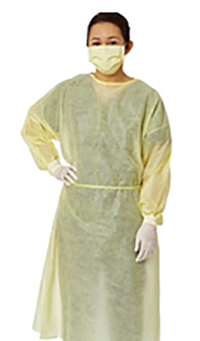
A fluid-resistant or impervious disposable garment made of synthetic materials worn to provide protection to the wearer from the transfer of microorganisms, body fluids and particulate material.
Surgical Gown
A fluid-resistant, disposable garment made of natural and/or synthetic materials worn over a scrub suit to cover the arms, trunk, and upper legs, during a surgical procedure, to help protect both the patient and operating room personnel from the transfer of microorganisms, body fluids, and particulate material.
Selection and use
Gowns are designed to provide complete protection in their critical zones, which are areas where direct contact with blood, body fluids and other potentially infectious materials is most likely to occur. The critical zones for isolation gowns comprise the entire gown, including the seams but excluding the cuffs, hems, and bindings. The manufacturer shall provide detailed information on the barrier performance of each critical zone component.
To ensure these gowns fit correctly, and protect against exposure to body fluids and infectious materials at the critical zones, they should cover the wearer from the neck to the knees and sleeves should finish at the wrists with cuffs. They should have enough overlap at the back that they do not separate when the person wearing them is sitting and come to below the knee.
Isolation Gowns
Isolations gowns are a key part of the suite of personal protective equipment (PPE) used by health care workers and patients to reduce the transfer of microorganisms and body fluids. Isolation gowns are classified according to the Association of the Advancement of Medical Instrumentation (AAMI) standards, which define four levels of liquid barrier protection (Levels 1–4) ranked from lower to higher levels of protection.
- When procuring gowns, please refer to the product labelling to determine if the level of protection offered is suitable for the situation the gown will be used. Consideration of product names alone is unlikely to reveal the necessary information, as product names are not standardised. To help in reviewing the most useful aspects of a products' labelling and documentation, the TGA recommends focussing on:
- The standard applied for testing the product's performance - different standards have different requirements and it's important to check that applied standard actually tests in the area(s) of performance you are interested in.
- The material of construction and design of the product
- The quality of the product and manufacturing quality management system (QMS)—a QMS helps ensure that all products have equivalent quality to those the manufacturer actually tests for performance. A QMS provides confidence that product performance across batches and produced at different points in time are similar.
Standards
A manufacturer may refer to different types of standards when producing isolation gowns, including:
- Standards that can be applied broadly for any medical product
- Standards that specify performance requirements for certain types of products
- Standards, sub-parts of standards and published procedures that specify the test methods used to evaluate specific performance criteria for those products
Liquid barrier performance for Level 4 Isolation Gowns
The TGA requires all medical devices, including isolation gowns, be designed and constructed having regard to the generally acknowledged state of the art. This is specified in Essential Principle 2. This means that manufacturers should test their products in line with current, state of the art standards.
AAMI:PB70 is a current standard which describes the required tests for demonstrating barrier performance for different gown classification levels. This is summarised in Table 1 below.
| Levels | Test | Liquid Challenge |
|---|---|---|
| 1 - 4 | AATCC 42 Impact Penetration | Water |
| 2 - 4 | AATCC 127 Hydrostatic Pressure | Water |
| 4 | ASTM F1670 Synthetic Blood Penetration Test (for surgical drapes) | Surrogate Blood |
| 4 | ASTM F1671 Viral Penetration Test (for surgical and isolation gowns) | Bacteriophage Phi-X174 |
Critical testing areas
Gowns are designed to provide protection have critical zones, which are areas where direct contact with blood, body fluids and other potentially infectious materials is most likely to occur. Areas outside of the critical zones can also be inadvertently splashed or sprayed. The critical zones for isolation gowns shall comprise the entire gown, including the seams but excluding the cuffs, hems, and bindings, and shall have a barrier protection of at least Level 1. The manufacturer shall provide detailed information on the barrier performance of each critical zone component.
Example of critical zones on a gown intended for isolation applications, adapted from Figure B.2 in AAMI PB70:2012

Note
The entire isolation gown (areas A,B, and C), including seams but excluding cuffs, hems, and bindings, is required to have a barrier performance of at least Level 1
Material and Design of isolation gowns
Disposable (single-use) isolation gowns are constructed of materials that offer increased protection from fluid penetration, such as plastic films. They can be produced using a variety of non-woven fibre-bonding technologies (thermal, chemical, or mechanical) to provide integrity and strength. Level 4 isolation gowns are usually made up of three- layered tri-laminated materials, with spunbond polypropylene as the outer/inner layers and a melt blown layer in between the spunbond layers.
Seaming techniques with fluid resistance properties are used to construct isolation gowns. Two commonly used techniques are taped seams (chemical bonding), and ultrasonically welded seams. The AAMI:PB70 standard does not specify that a certain type of seam is required to comply with the standard, and gowns with both types of seams can be shown to meet regulatory requirements and to be safe to use in a clinical setting.
Users and procurement officers should seek advice from the supplier on the standards that have been complied with, and how those standards were complied with. Specifically, users and procurement officers should seek information regarding the intended use of the product, the design of the product for that intended use, and whether the manufacturing was conducted under a suitable quality control system.
Product Quality
When choosing a product, it is crucial for a product to be manufactured from a reliable, valid, and quality source. It is also recommended to request the supplier of the product to submit any evidence to support the performance claims and that the test certificates be from a laboratory holding accreditation from NATA [1] (or equivalent accreditation issued by an ILAC [2] certified body) for the test(s) applied.
Quality management systems accredited to ISO 13485:2016 or ISO 9001:2015 also demonstrate an organizations ability to provide medical products that consistently meet customer and applicable regulatory requirements.
Lastly, an appropriate sampling plan is critical in ensuring the results are reflective of the quality of the product group for which samples are drawn from. As referenced by the majority of the standards relating to gown performance, the TGA would expect the product to meet the acceptable quality limit (AQL) of 4.0% and rejectable quality level (RQL) of 20%. This would generally mean 32 samples are tested per batch, per critical zone, with an overall pass result having 3 or less failed samples per tested batch and an overall fail result having 4 or more samples fail.
Specifically for taped (Chemically bonded) seams, the procurement officer may consider requesting specific engineering data around the tape and adhesives used in the tape. Considerations may include:
- Chemicals or known products or organisms that may weaken or degrade the adhesive strength.
- Validated design use cases for the adhesive.
- Manufacturer and quality management controls of the Adhesive manufacturer.
- Specific test data (or certificates) showing the fluid resistance of the gown at seam locations.
- Ensure batch numbers are identified on test reports.
Test Reports
The TGA recommends that the customer be aware of the following when reviewing test reports for level 4 isolation gowns provided by the supplier:
- Product testing was conducted by competent laboratories ILAC accredited to ISO/IEC 17025, and the testing performed must be within the scope of the laboratory's ISO/IEC 17025 accreditation.
- Product was tested under standard AAMI PB70:2012, be supported by further testing under:
- ASTM F1670
ASTM F1671
Note: Solely testing under AATC TM127-2017(2018)e or AATC TM42-2017e does not meet the barrier requirements of a Level 4 Isolation Gown.
- The critical zones of the product were tested as outlined in ANSI/AAMI PB70:2012, and the manufacturer provided detailed information on the barrier performance of each critical zone component.
- The testing location on each critical zone is randomised to ensure that all aspects of the critical zone is covered.
- The testing certificate relate to the product or product batch that is to be supplied to the procurement officer.
- The testing certificate includes visual representation (ie. photos) of the critical zones targeted.
Guidance on Crisis Supply
While not recommended, where there is low supply and/or high demand, gowns could be used as follows in crisis response measures:
- Expired sterile surgical gowns may be used as single use isolation gowns as they provide a physical barrier for isolation care.
- Healthcare providers may continue to wear the same gown between treating patients with the same diagnosis or infectious disease, such as COVID-19, providing they are being cared for in a confined area. If there are other concomitant infections present, such as C. difficile or MRSA, wearing the same gown between treating patients is not an appropriate action.
- Cloth gowns may be used where they are able to be re-processed as isolation protective equipment.
- Aprons should be worn underneath gowns which are not fluid resistant.
Goggles

A personal protective device in the form of eyewear/glasses with clear lenses intended to be used to shield the eyes of healthcare staff from blood and other body fluid splashes while performing a clinical or laboratory procedure. It is designed as uncorrected (non-prescription) or corrected (prescription) goggles or spectacles with lenses and side shields. The lenses and side shields offer additional physical barrier protection.
Visors
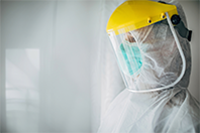
A transparent personal protective device intended to shield the face and eyes of a healthcare worker from unnecessary exposure from blood and other body fluid splashes while performing a clinical or laboratory procedure. Visors are suitable for use with prescription lenses and protective masks.
Gloves
Medical gloves are disposable and include examination gloves, sterile gloves and medical gloves for handling chemotherapy. Gloves are used during medical examinations and procedures to help prevent cross-contamination between healthcare providers and patients and vice versa, as well as from one patient to another.
The World Health Organisation (WHO) recommends, as a general policy, that examination gloves be powder free to avoid reactions with alcohol-based hand rubs used in healthcare facilities. If there are no other gloves available, powdered gloves should be used to maintain infection control standards.
Gloves should be used during all patient-care activities that may involve exposure to blood and all other body fluids (including contact with the mucous membrane and non-intact skin); during contact precautions; and outbreak situations. It is important to monitor the integrity of gloves and change them as soon as possible following appropriate hand hygiene measures.
All medical gloves are single-use items and, according to the WHO, there are no standardised, validated and affordable procedures for safe glove re-processing available.
Local hand hygiene policy should be followed before applying gloves and when removing or changing gloves. The wearing of gloves is not a substitute for hand hygiene. Gloves should be applied and removed following local policy and discarded appropriately.
Note
The use of petroleum-based hand creams or lotions following hand hygiene may affect the integrity of latex gloves.
For further information:
- Overview of how medical devices are regulated within Australia.
- Information about how to include medical devices (including in vitro diagnostic (IVD) medical devices).
- Therapeutic Goods (Declared Goods) Order 2019 declares particular goods or classes of goods to be therapeutic goods, or not to be therapeutic goods, for the purposes of the Act.
- For additional information relating to the regulation of face masks during the COVID-19 pandemic, see Face masks and respirators that are regulated by the TGA.
Contact information
If you have questions around supply of masks or gowns please contact the Office of Health Protection at health.ops@health.gov.au.
If you wish to report any adverse events or suspected adverse events experienced with gowns or surgical masks contact: IRIS@health.gov.au
For more information about face masks visit Face masks and COVID-19.



